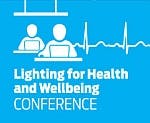At the Light+Building (L+B) mega event in Frankfurt last week, Seoul Semiconductor held its own symposium on Wednesday entitled the “Human centric light & health symposium.” The event was intended to imply the benefits of Seoul’s SunLike LED series, but the speakers were expert researchers from the US and Europe. Our colleagues at Lux have already written about the event, and specifically about the message of the featured speaker Russell Foster of Oxford University in the UK. Here, I’d like to add my thoughts to what Ray Molony reported.
Ray’s story focused on the fact that Foster said that we can’t do human-centric lighting (HCL) today because researchers still don’t fully understand how light affects the non-visual and circadian system in humans. I heard the same quotes that Ray accurately presented in his article. But I took the overriding message a bit differently.
I did not hear Foster suggest that the solid-state lighting (SSL) industry should cease and desist in deploying tunable lighting in an attempt to positively impact human circadian health or overall productivity and wellbeing. He certainly said that the industry doesn’t fully understand the impacts and that no proven recipes exist. But he did not sound an alarm about ongoing projects around the globe doing unnecessary harm to the people living and working under the lighting being used in such projects.
Foster said researchers fully understand the human visual system, and for the most part also understand the non-visual system based on the intrinsically photosensitive retinal ganglion cells (ipRGCs). Indeed, Foster said researchers do generally understand the intensity and duration of light that can stimulate the non-visual system and potentially impact circadian health or overall wellbeing.
But Foster also said there is something else at play in lighting for health. He suggested that there may be an interaction between the rod-and-cone system and pathways to the brain and the ipRGC pathways to the brain. Indeed, he said it appears that the rods and cones can modulate the activity of the ipRGCs. But there is more work to be done to go beyond what so far has only been correlation of light exposure and positive or negative impacts on humans.
We covered similar ground after our Lighting for Health and Wellbeing Conference last year. Jamie Zeitzer of Stanford noted that 20,000-lx light indoors would be very uncomfortable to the average person, yet we generally perceive 20,000 lx outside on a sunny day as delightful. Zeitzer said there is some sort of undiscovered gain control involved.
Back to L+B, Foster did say a few things that run counter to much of what you read in the industry. It takes much higher levels of light (perhaps thousands of lux) to impact the non-visual system. That threshold is higher than what is currently being supplied in mainstream lighting products. Indeed, even bright street lights would not stimulate the non-visual system without long exposure times. And he said that reading a tablet or smart device before bedtime, even for several hours, would have a minimal impact on the circadian system.
Still, he did say that the SSL industry can’t truly develop human-centric lighting products until we know more.






